Sparta, Peloponnese, Greece 2/2014
It was a short drive from Mystras to (new) Sparta, founded in the 1830s when Mystras was basically abandoned. Sparta became a prominent city-state in ancient Greece and was unique for its social system and constitution, which completely focused on military training and excellence. Around 650 BC, it rose to become the dominant military land-power in ancient Greece. Spartan women enjoyed considerably more rights and equality to men than elsewhere in the classical world. The word “Spartan” has been immortalized describing strict self-discipline & self-denial or avoidance of luxury or even undaunted by pain or danger.
There’s much more interesting history about Sparta, more than we want to relate here. Actually, we had olives on our minds. The earliest written testimony on the name of the olive tree, its fruit and its oil in the Greek language was found on clay tablets in the archives of Bronze Age houses, principally in Knossos on Crete, (14th c. BC) and not too distant Pylos, (13th c. BC). The tablets contained information on the production and circulation of olive oil. Olive oil was part of the so-called “Mediterranean triad” along with wheat and wine. It dominated all aspects of ancient Greek culture including economy, diet, hygiene, religious rituals and folk customs.
Olive oil of good quality was often perfumed with aromatic herbs and used for cleansing and beautifying the body. Ancient Greeks actually considered the oil more essential for personal care than food. They smeared the body with oil after bathing, before sexual intercourse, before exercising and even before going into battle. Olive oil is also a basic ingredient of soap, the use of which in hygiene was known but limited. As soap became more popular, it slowly replaced oil for cleaning the body.
Jumping to the present time, we are all certainly aware of the benefits of the “Mediterranean Diet”, of which olive oil plays an important part. It just so happens that Greece is the third-largest producer of olive oil in the world. In the process of researching a story for a magazine on California olives, which, by the way, are becoming quite famous, we had visited a couple of olive ranches and olive presses. There was much more to learn, and that brought us to the fascinating Museum of the Olive and Greek Olive Oil in Sparta where Director, Dimitris Viris, patiently answered all our hundreds of questions.
The museum is one of several designed and operated by the Piraeus Bank Group Cultural Foundation, the same organization that had developed the Water Power Museum we had previously visited. It was a world-class job of displaying both modern and historical artifacts. There were amazing old olive presses and modern examples of how it’s done today. While we all have the idea that the best olive oil is “1st cold press Extra-Virgin”, in fact, most olive oil is “1st cold press” and “Extra-Virgin” refers to its acidity. A low acidity, 0.1- 0.5%, allows the oil to be categorized as “Extra-Virgin”. This low acidity is a result of proper handling. Just sitting in the truck for a day or two before the harvested olives are pressed can result in a higher acidity reducing it to just “Virgin”, 0.6-1.0%. There are also insects that can raise the acidity.
At the presses we visited in California, the remains of the seeds, skins and stems are basically discarded, used as fertilizer in the orchards. In Greece and other Mediterranean countries the remains after the first pressing go through any number of elaborate processes with steam, heat and chemical treatment to produce lower quality olive oils and a number of industrial products. Historically olive oil was also used for lamp oil.
Evening was approaching fast and so we invited Dimitris for dinner. He brought us to Chromata, a charming grotto type restaurant in nearby Mystras. The stable of the old house was converted to a cozy restaurant with a wood burning stove and the back wall was the actual rock protruding into the dining area. Candle lit tables gave it a romantic note. We tasted various fabulous appetizers that the owner/chef, Nicos Grivas, created. One was his grandmother’s recipe.
The photos below will give you some idea of this wonderful museum. In Greece alone there are 29 varieties of olives. The wild olive tree is harvested for firewood but not the olives. They are very bitter. Olive oil, like wine, as many varietals and preference mostly depends on the individual tastes. One of our own favorites in California is the spicy Mission variety brought over by the Jesuits and now extinct in Europe, but there are many others available. Grab some bread and dip into a few varieties to find which one you like.
- The earliest written testimony on the name of the olive tree, its fruit and its oil in the Greek language was found on clay tablets in the archives of Bronze Age houses, (13th c. BC).
- Olive oil was often perfumed and smeared on the body after bathing, exercise and other fun activities. You will notice in this photo the interesting strigils (body scrapers) we previously saw in Olympia.
- Olive oil was stored in clay urns.
- Many types of hand driven oil presses were documented as far back as the Late Bronze Age (1600-1100 BC and continued to be widely used for domestic production of olive oil until modern times. The Sparta museum had some amazing examples.
- This antique olive press actually had a feeder box.
- Monika tries out a replica of an old olive press. Too bad there were no olives available.
- A staff member at the Greek Olive and Olive Oil museum made us a batch of traditional Greek Coffee. It was a very interesting
- More modern versions of olive presses sandwiched the fruit between layers of mats and pressed the oil out.
- We enjoyed wonderful Greek mezas in the nearby charming grotto-type restaurant Chromata. After several of these appetizers there was no reason to order a main dish.
- One of the many advantages of traveling in your self-contained camper is being able to park and sleep right in front of museums as we did in Sparta.



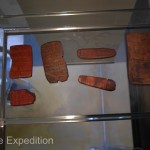
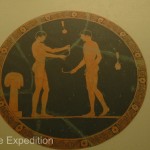
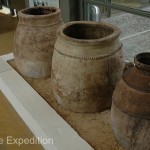

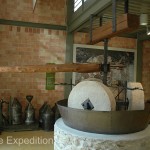

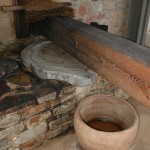
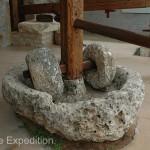
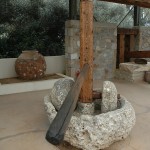
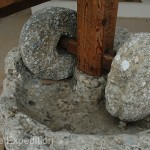
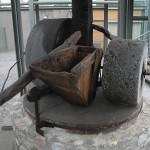
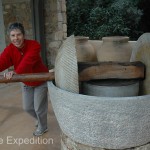
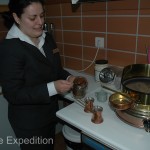
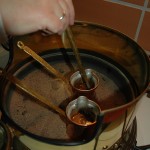
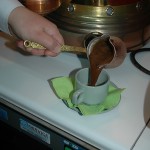














Leave a Comment